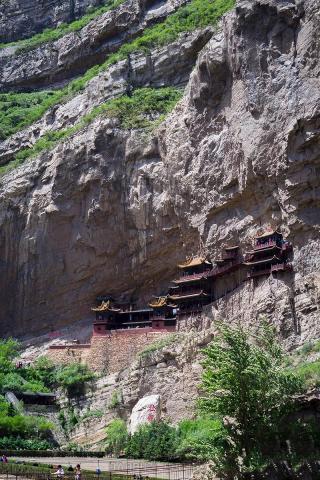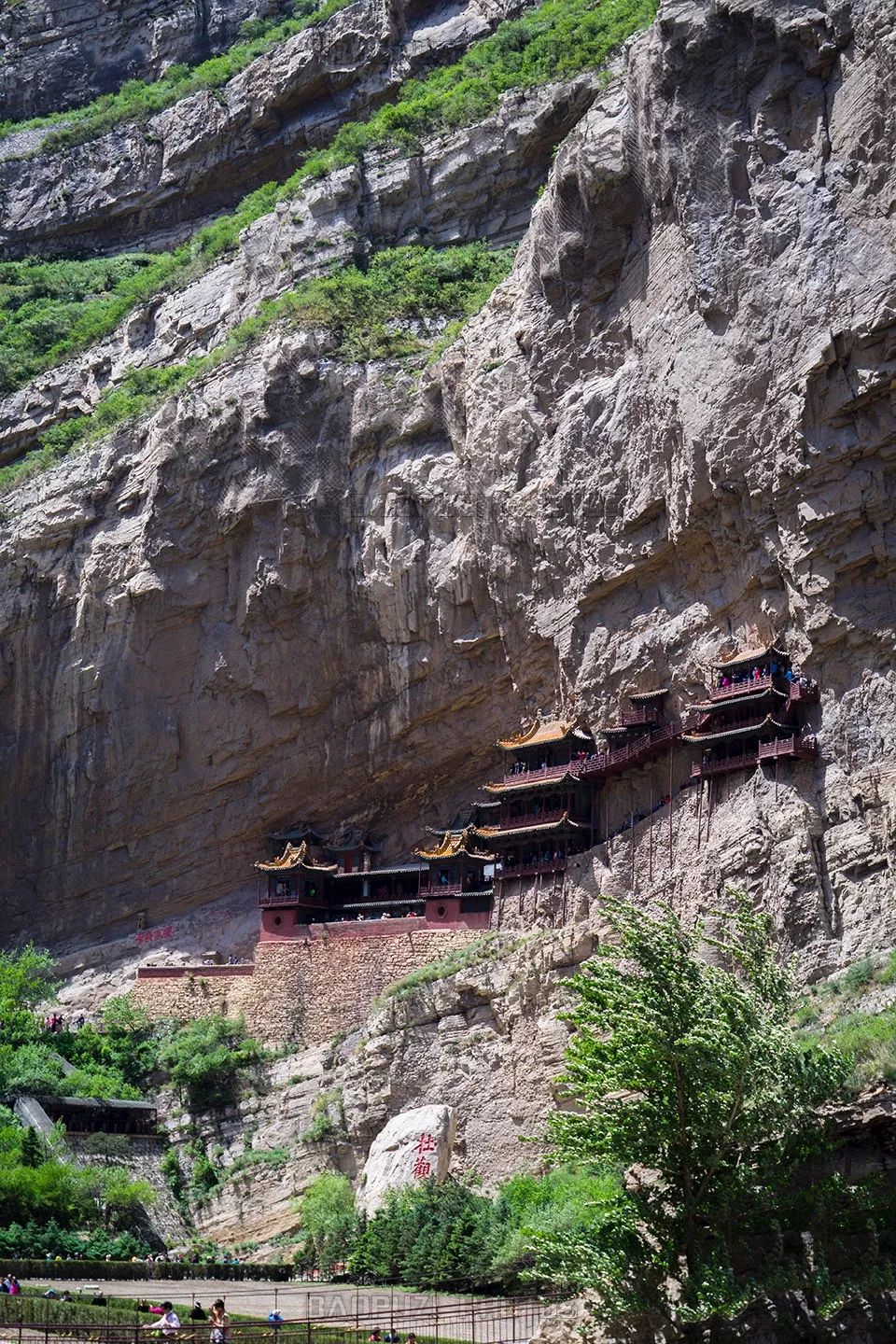
I hurriedly walked to the Xuankong Temple today. There are several temples built in the sky in China. Before I came to the Xuankong Temple in Shanxi, I had been to Xishan Longmen in Kunming and Daciyan in Jiande, Zhejiang. They are both known for their temples built on the cliffs halfway up the mountain. Hanging Temple. But the most famous one is the Xuankong Temple in Hunyuan, Shanxi that we came to today.

Xuankong Temple, also known as Xuankong Temple, is located between a cliff on the Cuiping Peak of Hengshan Mountain in Beiyue. It is the earliest existing Buddha, Taoist , in China It is a unique temple where Confucianthree religions are integrated into one, dating back nearly 1,500 years. Most of the buildings we see now are relics restored during the Qing Dynasty. The Xuankong Temple is about 50 meters high from the ground. Its architectural features can be summarized in three words: "strange, hanging and clever".

It is called "strange", the strange thing is Design and site selection: The Hanging Temple is located in a small basin in a deep mountain valley. The whole temple is suspended in the middle of a cliff. The protruding part of the cliff peak is like an umbrella, which protects the ancient temple from rain. When the floods below the mountain are flooded, it is also protected from being flooded. The surrounding mountains also reduce the exposure time of sunlight. The superior geographical location is one of the important reasons why the Hanging Temple can be well preserved.

Say it is "hanging", hanging on There are 40 halls and pavilions in the whole temple. On the surface, they seem to be supported by more than a dozen wooden pillars as thick as bowls. In fact, some wooden pillars are not under stress at all. It is said that when the Hanging Temple was built, these wooden piles did not exist. It was just that people saw that the Hanging Temple seemed to have no support and were afraid that the temple would fall down when they walked up. In order to reassure people, some wooden pillars were placed under the temple. Therefore, some people use "Hanging Temple, half a day high, three horsetails hanging in the air" to describe the Hanging Temple. The real center of gravity is supported in the hard rock. The rock is chiseled into a shape similar to a right-angled trapezoid, and then the flying beam is inserted to make it fully close to the acute angle part of the right-angled trapezoid, and the half-inserted flying beam is used as the basis based on the principle of mechanics. In addition, the wood used for the flying beam of the Hanging Temple is processed from the local specialty iron fir wood. It is said that it is soaked in tung oil, so it is not afraid of termites and has an anti-corrosion effect. Therefore, it is not a miracle that the Hanging Temple has not fallen for thousands of years, but the crystallization of people's wisdom.

It is called "clever", clever in that When building the temple, they adapted to local conditions and made full use of the natural state of the cliffs to arrange and construct the various parts of the temple. The layout and form of the general temple's flat buildings were built in a three-dimensional space. There are mountain gates, bell and drum towers, main halls, side halls, etc., and the design is very exquisite.
 The mountain gate of Xuankong Temple is not as grand as imagined, but two small doors that only allow one person to walk through. After passing through these doors, you really enter the Xuankong Temple. The temple is crowded with people.
The mountain gate of Xuankong Temple is not as grand as imagined, but two small doors that only allow one person to walk through. After passing through these doors, you really enter the Xuankong Temple. The temple is crowded with people.



 The layout of the temple is a two-story palace surrounded on three sides. There are two pavilion-like buildings facing east and west. We passed through the second pavilion as people flowed. It is said that it is not a pavilion, but it is just a stairwell. When I climbed the stairs, I found that the stairs were covered with iron sheets and then nailed together with iron nails. The patterns of the iron nails were different. They were used to reduce the It not only reduces the wear and tear of the wooden stairs, but also increases the friction so that the iron sheet will not be too slippery. The flow of people pushed us to the second floor.
The layout of the temple is a two-story palace surrounded on three sides. There are two pavilion-like buildings facing east and west. We passed through the second pavilion as people flowed. It is said that it is not a pavilion, but it is just a stairwell. When I climbed the stairs, I found that the stairs were covered with iron sheets and then nailed together with iron nails. The patterns of the iron nails were different. They were used to reduce the It not only reduces the wear and tear of the wooden stairs, but also increases the friction so that the iron sheet will not be too slippery. The flow of people pushed us to the second floor.



There is a cave behind the second pavilion, because you will see rows of palaces there. And this is also the essence of the Hanging Temple. They are the South Tower and the North Tower respectively, connected by a plank road in the middle.

The south building is three stories high, about 8 meters long and 4 meters wide. It contains Chunyang Palace, Sanguan Palace, Sanjiao Palace and Leiyin Palace. The Chunyang Palace on the lowest floor, also known as Luzu Temple, is mainly dedicated to Lu Dongbin, one of the Eight Immortals of Taoism; the Three Palaces on the middle floor are the largest palaces in the entire Xuankong Temple building. The statues in the palace are clay sculpture treasures from the Ming Dynasty; the three official fingers The Heavenly Official who blesses people, the Earthly Official who forgives sins, and the Water Official who relieves people from misfortune. The clay sculpture is about 2 meters high and is the largest statue in the Xuankong Temple. Below it are maids, young and old ministers, Marshal Tianpeng, and the two generals Turtle and Snake. The Leiyin Hall on the top floor is a Buddhist temple located at the highest point of the south tower. Buddhism believes that when the Buddha Sakyamuni preached Buddhism, his voice was as loud as thunder, so it is called Leiyin Hall.

The North Tower is three stories high, about 7 meters long and 4 meters wide. It houses the Hall of Five Buddhas, the Hall of Guanyin and the Hall of Three Religions respectively. The Five Buddha Hall is located on the lowest floor and is named after the five Buddhas. The Guanyin Hall is on the middle floor of the building; the Three Religions Hall is a typical palace that embodies " the unity of the three religions " and is located on the top floor of the third part of the Hanging Temple. Three religious leaders gather together, in the middle is Sakyamuni, the founder of Buddhism, on the left is Confucius, the founder of Confucianism, and on the right is Laozi, the originator of Taoism. The three religions are worshiped in one hall, which is extremely rare in temple buildings across the country.
 There was a lot of reluctance when we started to return amidst the surging flow of people, but we had to go. "On Feige Danya, the white clouds have closed several times, the mirages are suspicious of the sea, and the birds have disappeared from the clouds." The visit to the Xuankong Temple ended with a rush of appreciation. I walked down from the Xuankong Temple and came to the "Spectacular" inscribed by Li Bai. In front of the stone monument, I looked back at the Hanging Temple on the mountain. It seemed a bit quiet and mysterious. I suddenly thought of the hanging coffin on Guifeng. There was something connected between placing the body in a cliff cave after death and practicing in the cliff temple during life. place? No matter what, in this wilderness and cliff place, isolated from the hustle and bustle of the world, what the ancients pursued was their tranquil state of transcendence. Only in this quiet and mysterious state of mind can there be temples and hanging coffins suspended in time and space, and only then can there be this tranquility where no one hears the sound of chickens and dogs, and no contact between old age and death.
There was a lot of reluctance when we started to return amidst the surging flow of people, but we had to go. "On Feige Danya, the white clouds have closed several times, the mirages are suspicious of the sea, and the birds have disappeared from the clouds." The visit to the Xuankong Temple ended with a rush of appreciation. I walked down from the Xuankong Temple and came to the "Spectacular" inscribed by Li Bai. In front of the stone monument, I looked back at the Hanging Temple on the mountain. It seemed a bit quiet and mysterious. I suddenly thought of the hanging coffin on Guifeng. There was something connected between placing the body in a cliff cave after death and practicing in the cliff temple during life. place? No matter what, in this wilderness and cliff place, isolated from the hustle and bustle of the world, what the ancients pursued was their tranquil state of transcendence. Only in this quiet and mysterious state of mind can there be temples and hanging coffins suspended in time and space, and only then can there be this tranquility where no one hears the sound of chickens and dogs, and no contact between old age and death.
Xuankong Temple, Xuankong Temple; the temple is suspended in mid-air, and the soul is released into the Xuankong. This trip is not in vain.

